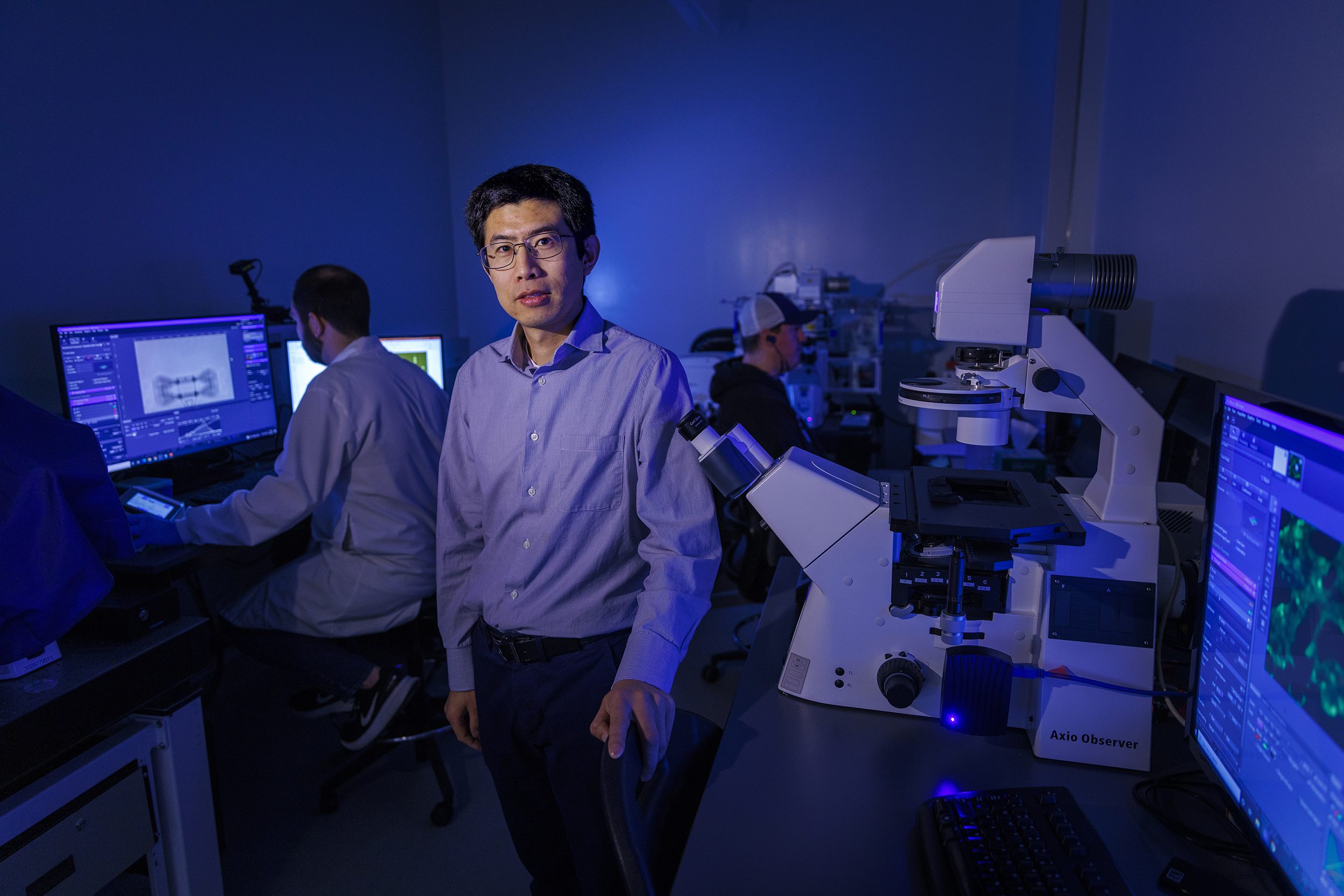
A University of Nebraska–Lincoln researcher is using National Science Foundation funding to take a closer look at how cell-cell junctions — the protein structures that enable cells to attach to their neighboring cells — respond to the wide range of strains they’re subjected to every day, such as cardiac pulses, stretching of the skin and peristalsis in the gut.
Ruiguo Yang, assistant professor of mechanical and materials engineering, is using a $540,000 grant from NSF’s Faculty Early Career Development Program to explore how cell-cell bridges respond to strains of different magnitudes and rates. Since these junctions maintain tissue integrity and regulate cell-to-cell signaling, understanding their response to strain could shed light on the mechanics of diseases like cancer, genetic mutations in the heart, autoimmune skin conditions and more — and offer clues about how to effectively treat them.
“Our goal is to understand, when tissues are experiencing these strains, how do they respond?” Yang said.
The work builds on a paradigm-shifting study Yang’s team published last year in the Proceedings of the National Academy of Sciences. It recorded, for the first time, the biomechanical behavior of individual cell-to-cell junctions under defined strain — a feat made possible by the group’s fabrication of a microscopic apparatus that mimics the physiology of a cell-cell bridge. That platform is attached to an atomic force microscope, which generates displacements that replicate the strains faced by junctions in the human body.
That system — the result of about five years of work — provides the foundation for Yang’s CAREER research, which has two trajectories. The first explores situations where strain does not rupture the cell-cell junction. In these cases, cells adapt to strain by undergoing a process broadly known as mechanotransduction: Cells convert mechanical stimuli into biochemical signals, which in turn trigger cellular responses.
Cell junctions use this adaptive process to circumvent breakage under strain. Rather than breaking the bridge, the strain triggers cell elongation via remodeling of the cell’s cytoskeleton, the web of fibers in the cytoplasm that gives cells shape and support. Yang aims to pinpoint exactly what prompts the adaptation process.
“Something has to give that signal,” he said. “Is it coming from the junction site? Does it come from some other place? The first aim is to study how the signal gets into the cell, and then how the signal translates into the reality of cells extending or elongating themselves.”
When junctions cannot adapt to strain-induced stress, they rupture. These scenarios are the focus of Yang’s second research aim. He will study the chain of events that leads to breakage, including how and where stress accumulates in a cell, and how it ultimately breaks the bridge.
He’s particularly interested in identifying how different types of molecules at the junction behave during the rupture process. Identifying which ones confer stability, or fail early in the process, for example, may provide clues about how certain diseases wreak havoc on the body — and how that process could be reversed.
“If we get a disease caused by a rupture, we can find a drug that strengthens those particular pathways to make those molecules more stable,” Yang said.
Across both research aims, Yang is trying to discern how cells and their junctions behave at different sites across the body. In different locations — the heart versus the skin versus a blood vessel, for example — cells have different structures and different molecules at their junctions. He’ll test different cell lines to determine whether the mechanotransduction process is universal, or if it changes according to cell type.
Yang’s work is innovative for its position at the intersection of biology and engineering. To this point, there has been significant focus on how cells connect to their extracellular matrix — the protein bed on which they’re anchored. That’s because the method for studying those linkages falls squarely into traditional bioengineering approaches: Researchers can replicate those connections easily by throwing cells into a dish with media that mimics the extracellular matrix. But representing cell-to-cell junctions is much more difficult, which is why Yang’s fabrication of the cell bridge platform was pivotal for this next phase of work.
Yang’s research has significant potential for clinical application down the road. He and collaborators are studying the role of cell-cell adhesions in the rare autoimmune disease pemphigus vulgaris, a condition where the patient’s antibodies attach to the molecules that hold skin cells together. This ultimately breaks the junctions, which presents clinically as skin blistering and erosion.
Other diseases of interest include cancer, as metastasis involves the breakdown of cell-cell junctions, as well as anchorage-independent growth, where tumor cells proliferate without connection to the extracellular matrix. Genetic mutations of the heart, where junctions have not formed properly and are susceptible to strain-induced damage, are also on Yang’s radar.
Yang will integrate various groups of students into his research. For Husker undergraduate students, he’s launching a laboratory mentoring program that focuses on the fusion of the physical sciences, life sciences and engineering. Undergraduates from varied disciplines will team up with graduate and postdoctoral mentors to pursue interdisciplinary projects.
Yang will engage middle and high school students through an education platform known as iCube, which stands for interdisciplinary, integrated and interactive. They’ll be able to use joysticks or household gaming devices, like the Xbox game controller, to participate in various cell manipulation tasks.
The National Science Foundation’s CAREER award supports pre-tenure faculty who exemplify the role of teacher-scholars through outstanding research, excellent education and the integration of education and research.








